
The Magic of QR Codes: How Those Little Squares Store So Much Information
The Magic of QR Codes: How Those Little Squares Store So Much Information
Published on: October 1, 2025
Tags: Advance Web Development, qr-codes, Web Development
Unlock the magic of QR codes! 🧐 This definitive guide reveals how those little squares store so much data, their innovative uses in 2025, and best practices for security and scanning. Click to learn everything about QR technology!
You see them everywhere—on restaurant menus, product packaging, business cards, and billboards. Those pixelated black-and-white squares known as QR (Quick Response) codes have become a seamless bridge between our physical and digital worlds. But have you ever stopped to wonder how they actually work? How can a small, static image possibly hold a website URL, a contact card, or even a Wi-Fi password?
This article demystifies the technology behind QR codes. We’ll explore their ingenious structure, reveal their modern applications, and provide actionable tips for using them safely and effectively. Ultimately, you’ll understand not just the “what,” but the truly fascinating “how.”

Deconstructing the Magic: How QR Codes Actually Work
At first glance, a QR code appears to be a random collection of squares. In reality, it’s a highly organised and efficient data storage system. Think of it as a sophisticated, two-dimensional barcode. While traditional barcodes store information in one direction (horizontally), QR codes store data in two directions (both horizontally and vertically). This fundamental difference is why they can hold hundreds of times more information.
The Key Components of a QR Code
Every QR code is built with several critical sections that work in harmony:
- Finder Patterns: The three large squares in the corners. These act as anchors, indicating to the scanner the boundaries of the code and ensuring it can be read from any angle.
- Alignment Pattern: A smaller square near the bottom-right corner. This helps correct for distortion, especially on larger codes or curved surfaces.
- Timing Pattern: A line of alternating black and white modules that runs between the finder patterns. This helps the scanner determine the size of the data modules and create a coordinate grid.
- Quiet Zone: The essential white border surrounding the code. Without this empty space, scanners cannot distinguish the QR code from its surroundings.
- Data Modules: The central black and white squares that contain the actual encoded information. This is the heart of the code.
The Language of Ones and Zeros
The core principle is beautifully simple. Each black module represents a “1,” and each white module represents a “0.” A QR code reader, like the camera on your smartphone, captures an image of the code. Subsequently, software processes this image, identifies the patterns, and translates the grid of black and white squares into a string of binary code. Finally, this binary data is decoded into human-readable information, such as a web address or a piece of text.
Beyond the Menu: The Evolution of QR Codes in 2025
QR codes have evolved far beyond their initial use in manufacturing. Today, they are powerful tools for marketing, logistics, and customer engagement. Here are some of the most impactful modern applications:
- Dynamic QR Codes: Unlike static codes, dynamic QR codes allow you to change the destination URL without changing the physical code itself. This is perfect for tracking scan metrics, running A/B tests, or updating campaign links.
- Secure Digital Payments: Platforms like PayPal, Venmo, and numerous banking apps use QR codes to facilitate instant, secure peer-to-peer and merchant transactions.
- Enhanced Customer Onboarding: From connecting to Wi-Fi without a password to downloading an app or viewing a digital manual, QR codes remove friction from the user experience.
- Interactive Packaging: Brands use QR codes on products to share origin stories, provide recipes, offer loyalty points, or promote sustainability initiatives.
- Digital Business Cards: A simple scan instantly saves a contact’s name, number, email, and social profiles directly to your phone’s address book.
Overcoming QR Code Challenges: Standing Out in a Noisy World
Despite their utility, QR codes face real-world challenges. The prevalence of “zero-click searches” (where users get their answer directly from the search results page) and low click-through rates (CTR) on digital assets means your QR code needs to work hard to earn a scan.
Strategies to Boost Engagement and CTR
How can you make your QR code irresistible?
- Provide Clear Value: Always tell users why they should scan. Use a compelling call-to-action (CTA) like “Scan to Get Your Exclusive Discount” or “Scan to Watch the Product Video.”
- Design with Branding: Use custom QR codes that incorporate your logo and brand colours. However, always test them thoroughly to ensure they still scan reliably.
- Optimise the Destination: Ensure the landing page is mobile-friendly, loads quickly, and delivers exactly what was promised. There’s no faster way to lose trust than a broken link or a poor user experience.
- Ensure Flawless Scannability: Place codes in well-lit areas, ensure a high contrast between modules, and make them a practical size for a smartphone camera to focus on.

Creating and Using QR Codes Safely: A Best Practices Guide
Ready to harness the power of QR codes yourself? Follow these actionable steps for success.
Generating Your Own Code
Creating a QR code is simple and often free. Many online generators allow you to create codes for URLs, text, Wi-Fi, and more. For professional use, consider platforms that offer dynamic code features and analytics.
Critical Security Tips for Scanners
While incredibly useful, QR codes can be exploited by malicious actors. Follow these safety rules:
- Use a Scanner with a Preview: Many modern smartphone cameras and dedicated scanner apps now show the destination URL before opening it. Always check this preview.
- Be Wary of Codes in Public Places: Avoid scanning unsolicited codes on stickers or posters in random locations, as they could lead to phishing sites.
- Keep Your Phone Updated: Regular OS updates include security patches that protect against emerging threats, including QR-based vulnerabilities.
Your QR Code Questions, Answered (FAQ)
Q1: How much data can a QR code actually hold?
A: It varies by the QR code’s version and error correction level. However, a standard QR code can store up to about 3KB of data. This translates to roughly 4,000 alphanumeric characters or 7,000 numeric digits.
Q2: What’s the difference between a QR code and a barcode?
A: The primary difference is dimensionality. Barcodes are one-dimensional (1D), storing data in a horizontal line. QR codes are two-dimensional (2D), storing data in both horizontal and vertical grids, allowing them to hold significantly more information in a smaller space.
Q3: Can a QR code stop working if I change the information?
A: It depends. A static QR code is permanent; if you change the information (like a URL), you must generate a new code. A dynamic QR code, however, allows you to update the destination information at any time without changing the physical code.
Q4: Are QR codes secure to use?
A: Generally, yes. However, you should always be cautious. Only scan codes from trusted sources and use a scanner app or camera that shows you the destination link before opening it to avoid malicious websites.
The humble QR code is a testament to how elegant engineering can create profound utility. It’s a simple black-and-square pattern that effortlessly connects a physical moment to a digital universe of information, interaction, and opportunity.
Now that you’re a QR code expert, put your knowledge into action!
What’s the most creative use of a QR code you’ve ever seen? Share your ideas with our community in the comments below, and don’t forget to visit squareloops for more insights on the technology shaping your world.
Related Categories: Artification Intelligence (AI), CSS, hosting Solutions, Javascript, news, nodejs, React, SEO, Social, step-by-step guides, Uncategorized, Web Development, Webflow, wordpress